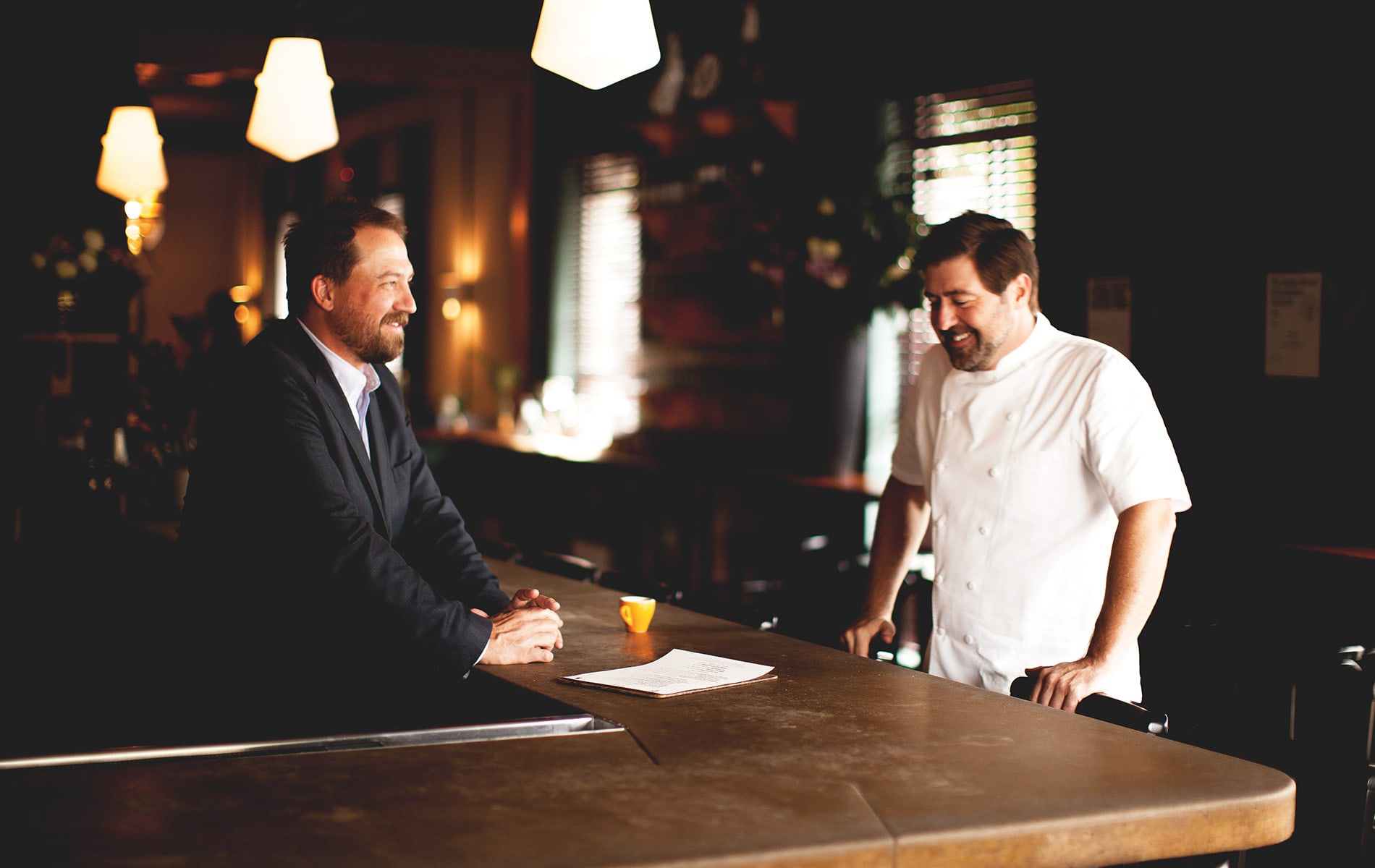
vie-magazine-fig-hero-min
FIG owners/founders Adam Nemirow and chef Mike Lata
FIG Leads the Charleston Food Scene
By Tori Phelps | Photography courtesy of FIG
If you’ve experienced the maddening pang of too many dining options and too little time during a trip to Charleston, South Carolina, you can thank Mike Lata and Adam Nemirow. The duo behind the iconic restaurant FIG intended only to launch a new eatery fifteen years ago, but they ended up starting a movement of simple ingredients given simple preparations, sourced almost entirely from local farms, fields, and seas.
It sounds, well, simple. But the concept was a Low-Country revolution that triggered a long list of imitators. Thank goodness. Because today, a region once dismissed by the culinary elite has become a mecca of award-winning restaurants that attracts diners and chefs from around the globe. Many say it all started with FIG.
For James Beard Award-winning chef Lata, FIG represents a life he always wanted but didn’t initially believe was an option. He knew early on that the kitchen was his happy place, learning the value of garden-grown produce at the knee of his Polish American grandmother and internalizing the care she took in picking everything that appeared on her family’s plates. Those were the days before cooking was considered an admirable life goal, and the Massachusetts native caved to pressure to pick a “real” career. He enrolled at UMass Amherst as a broadcast journalism major.
He couldn’t shake the cooking bug, though, and skipped class one day to attend a lecture by legendary chef Julia Child. When she waxed poetic about how food had changed her life and voiced a belief in its power to unite families and communities, Lata realized he was wasting his time pursuing anything else. “I quit school that day,” he says.
- Chef Lata’s homemade gnocchi might just be the best you’ve ever had.
- Chef Lata’s homemade gnocchi might just be the best you’ve ever had.
Lata threw himself into restaurant gigs in places like Boston, New Orleans, and Atlanta, working his way up the ladder with every stop. Eventually, he was recruited to run a local food program at Anson, a longtime Charleston restaurant. When Adam Nemirow joined the Anson team a couple of years later as the manager, the two hit it off immediately and realized their shared vision was more than the basis for a great friendship. It was the basis for a new kind of restaurant.
Nemirow, who was raised mostly in New England, was the front-of-house pro that completed Lata’s back-of-house expertise. Armed with an MBA from hospitality powerhouse Johnson & Wales, Nemirow came to Charleston because it “was the obvious choice” for restaurant-focused hospitality. The duo agreed to make all decisions together, but their specific skill sets meant Lata could concentrate on the menus while Nemirow put together an outstanding beverage program, trained staff, and tended to a million other not-so-glamorous details.
Inside FIG’s unassuming building at the corner of Meeting and Hasell Streets, business was somewhat “meh” in the couple of years following its 2003 debut. Feedback was positive, but the restaurant hadn’t really struck a chord yet. And then FIG got a visit from powerful New York Times food editor R. W. Apple Jr. Lata and Nemirow knew he was a reviewer, but they admit that they were too busy with the day-to-day slog to investigate. So, they did what they always do: they sent out a great meal.
When Apple’s glowing piece appeared shortly afterward, their lives changed forever. “We went from an up-and-down business to sold-out for six weeks straight,” Lata says. “That was our coming-out party.”
Apple, who had sampled pretty much every dish on the menu during his visit, was hooked by Lata’s clean, unfussy preparations. Like many chefs, Lata cooks with “taste memory,” and his is firmly anchored in the abundance of his grandmother’s garden. His minimalistic style speaks to the fact that he considers himself more craftsman than innovator, preferring to connect with diners through their memories of fresh, delicious food than to shock them with a “What is that?” dish.
- In addition to a robust dinner menu Monday through Saturday, FIG also has a mouthwatering array of small plates, wine and cheese, desserts, coffee, and craft cocktails.
- In addition to a robust dinner menu Monday through Saturday, FIG also has a mouthwatering array of small plates, wine and cheese, desserts, coffee, and craft cocktails.
It helps that he and Nemirow are adamant about sourcing so much of their menu items locally. Far more than just produce, local suppliers contribute everything from sweeteners to heirloom grains—and the list keeps growing. Lata estimates that 80–95 percent of their food, depending on the season, comes from within a couple hundred miles of Charleston. It’s a shocking percentage until you consider that Charleston is surrounded by water (seafood) and the area outside its city limits is mainly rural (everything else).
To help keep those numbers high, FIG’s menu changes daily. The owners’ commitment to working almost exclusively with local purveyors means Lata has had to develop a system of creative flexibility to use whatever they’ve grown or caught that day. Collards, for example, might appear as a baby collard salad when they’re tender and young, giving way a week or two later to a sauté-and-braise treatment. And FIG’s Nine Vegetable Salad? It’s always on the menu, but the chances of finding the same nine veggies on the plate two days in a row are slim.
If it sounds like a lot of work, that’s because it is. Lata doesn’t pretend otherwise, and he warns up-and-comers that a successful career in the kitchen demands an uncompromising work ethic. “I don’t require it in our restaurants, but if you’re not working from 9 a.m. until 1 or 2 a.m. in your twenties, you’re missing a lot,” he says. “You have to see the product come in, develop relationships with the growers, producers, and fishermen, and hand-hold the product all the way through to service. Until you understand the discipline involved in those things, you can’t be a great chef, regardless of your talent.”
But food is only one part of the equation at FIG. Nemirow’s management means that guests are guided through their experience by well-trained servers and sip from a nationally lauded beverage program. This one-two punch has led to uncommon success for the longtime partners, first with FIG and then with The Ordinary, an upscale King Street oyster hall that earned a James Beard nomination for Best New Restaurant when it debuted five years ago. Lata and Nemirow’s enviable partnership is kind of like a good marriage; they’ve learned how to pull together, how to communicate, and even how to fight. Tackling the restaurant business without the other seems unimaginable to them both. “It’s having someone to bounce ideas off of,” Lata explains of the benefits. “You can lean on the other person, and you’re there for them, too.”
Being in sync is essential when catering to a clientele that’s very sophisticated—and getting more so by the day.
Even when they intentionally buck trends, like when Nemirow stacked their wine list with nontraditional varietals to push guests to sample something new, the pair is confident that diners in their city are up for the challenge. The fact that their customers are willing to try almost anything makes Charleston chefs the envy of their peers, Lata says.
That’s one reason Lata wouldn’t want to be anywhere else. He calls Charleston “the greatest place in the world to be a cook,” thanks to unparalleled resources and a regional palate that’s identifiable, which is rare in the US. The city’s revitalized food culture, helped along quite nicely by FIG, doesn’t hurt either.

Fresh, locally sourced ingredients are the cornerstones of the restaurant’s menu.
FIG has been around for fifteen years now, but it continues to remain both commercially popular and critically acclaimed. The secret to that bit of culinary magic, Lata and Nemirow believe, is a combination of hard work and luck. When they opened their doors, there weren’t many places like it. And by the time competitors joined them, FIG was . . . FIG. It’s an ongoing effort to remain worthy of the hype—harder, perhaps, than raising the bar in the first place. But the owners agree that pressure to perform at the top of their game is a good thing. “We can’t sweep anything under the rug,” Nemirow says. “We owe our best not only to the guests but to the staff who joined the restaurant because of what FIG is.”
And what is FIG? It’s a simple neighborhood restaurant, claim Lata and Nemirow, handily downplaying its awards and cult-like following. The truth is that it’s both unpretentious and astoundingly good, thanks in large part to a menu that’s agile yet never trendy. “People are always going to be happy with the highest-quality, freshest ingredients,” Nemirow says. “That will never change.”
— V —
Tori Phelps has been a writer and editor for nearly twenty years. A publishing industry veteran and longtime VIE collaborator, Phelps lives with three kids, two cats, and one husband in Charleston, South Carolina.
Share This Story!
KEEP UP WITH THE LATEST STORIES FROM VIE




















































































































































